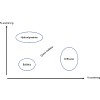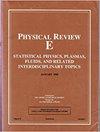用双耗散变量模拟热传导:机制-数据融合方法
IF 2.4
3区 物理与天体物理
Q1 Mathematics
引用次数: 0
摘要
在过去几十年中,基于查普曼-恩斯科格、赫米特或其他小扰动扩展方法开发了许多宏观非傅里叶热传导模型。这些宏观模型在捕捉固体材料的非傅里叶热行为方面取得了巨大成功,但它们大多受限于较小的努森数,无法捕捉高度非平衡或弹道热传输。在本文中,我们为构建宏观非傅里叶热传导模型提供了一种不同的策略,即使用数据驱动的深度学习方法,结合非平衡热力学而不是小扰动扩展。我们提出了机制-数据融合方法,这种方法将守恒-耗散形式主义(CDF)的严谨框架与机器学习的灵活性无缝结合起来,为非傅里叶热传导建模。利用具有双耗散变量的守恒耗散原理,我们推导出一系列可解释的偏微分方程,并根据声子波尔兹曼传输方程的数据,通过训练策略对其进行微调。此外,我们还介绍了内部步骤操作,以缩小从离散形式到连续系统的差距。通过数值测试,我们的模型在各种热传导状态(包括扩散、流体动力和弹道状态)下都表现出卓越的预测能力,即使在初始条件不连续的情况下,也能显示出其稳健性和精确性。本文章由计算机程序翻译,如有差异,请以英文原文为准。

Modeling heat conduction with dual-dissipative variables: A mechanism-data fusion method
Many macroscopic non-Fourier heat conduction models have been developed in the past decades based on Chapman-Enskog, Hermite, or other small perturbation expansion methods. These macroscopic models have achieved great success in capturing non-Fourier thermal behaviors in solid materials, but most of them are limited by small Knudsen numbers and incapable of capturing highly nonequilibrium or ballistic thermal transport. In this paper, we provide a different strategy for constructing macroscopic non-Fourier heat conduction modeling, that is, using data-driven deep-learning methods combined with nonequilibrium thermodynamics instead of small perturbation expansion. We present the mechanism-data fusion method, an approach that seamlessly integrates the rigorous framework of conservation-dissipation formalism (CDF) with the flexibility of machine learning to model non-Fourier heat conduction. Leveraging the conservation-dissipation principle with dual-dissipative variables, we derive an interpretable series of partial differential equations, fine tuned through a training strategy informed by data from the phonon Boltzmann transport equation. Moreover, we also present the inner-step operation to narrow the gap from the discrete form to the continuous system. Through numerical tests, our model demonstrates excellent predictive capabilities across various heat conduction regimes, including diffusive, hydrodynamic, and ballistic regimes, and displays its robustness and precision even with discontinuous initial conditions.
求助全文
通过发布文献求助,成功后即可免费获取论文全文。
去求助
来源期刊

Physical review. E
物理-物理:流体与等离子体
CiteScore
4.60
自引率
16.70%
发文量
0
审稿时长
3.3 months
期刊介绍:
Physical Review E (PRE), broad and interdisciplinary in scope, focuses on collective phenomena of many-body systems, with statistical physics and nonlinear dynamics as the central themes of the journal. Physical Review E publishes recent developments in biological and soft matter physics including granular materials, colloids, complex fluids, liquid crystals, and polymers. The journal covers fluid dynamics and plasma physics and includes sections on computational and interdisciplinary physics, for example, complex networks.
 求助内容:
求助内容: 应助结果提醒方式:
应助结果提醒方式:


